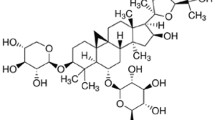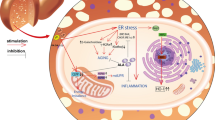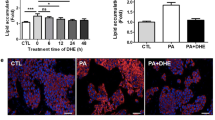Abstract
Intracellular long-chain acyl-CoA synthetases (ACSL) activate fatty acids to produce acyl-CoA, which undergoes β-oxidation and participates in the synthesis of esterified lipids such as triacylglycerol (TAG). Imbalances in these metabolic routes are closely associated with the pathogenesis of non-alcoholic fatty liver disease (NAFLD). Triacsin C is one of the few compounds that inhibit TAG accumulation into lipid droplets (LD) by suppressing ACSL activity. Here we report that treatment of primary rat hepatocytes with triacsin C at concentrations lower than the IC50 (4.1 μM) for LD formation: (i) diminished LD number in a concentration-dependent manner; (ii) increased mitochondrial amount; (iii) markedly improved mitochondrial metabolism by enhancing the β-oxidation efficiency, electron transport chain capacity, and degree of coupling – treatment of isolated rat liver mitochondria with the same triacsin C concentrations did not affect the last two parameters; (iv) decreased the GSH/GSSG ratio and elevated the protein carbonyl level, which suggested an increased reactive oxygen species production, as observed in isolated mitochondria. The hepatocyte mitochondrial improvements were not related to either the transcriptional levels of PGC-1α or the content of mTOR and phosphorylated AMPK. Triacsin C at 10 μM induced hepatocyte death by necrosis and/or apoptosis through mechanisms associated with mitochondrial permeability transition pore opening, as demonstrated by experiments using isolated mitochondria. Therefore, triacsin C at sub-IC50 concentrations modulates the lipid imbalance by shifting hepatocytes to a more oxidative state and enhancing the fatty acid consumption, which can in turn accelerate lipid oxidation and reverse NAFLD in long-term therapies.











Similar content being viewed by others
References
Alberici LC, Oliveira HC, Catharino RR, Vercesi AE, Eberlin MN, Alberici RM (2011) Distinct hepatic lipid profile of hypertriglyceridemic mice determined by easy ambient sonic-spray ionization mass spectrometry. Anal Bioanal Chem 401(5):1651–1659
Begriche K, Massart J, Robin MA, Bonnet F, Fromenty B (2013) Mitochondrial adaptations and dysfunctions in nonalcoholic fatty liver disease. Hepatology 58(4):1497–1507
Bligh EG, Dyer WJ (1959) A rapid method of total lipid extraction and purification. Can J Biochem Physiol 37(8):911–917
Boveris N, Oshino B (1972) Chance, the cellular production of hydrogen peroxide. Biochem J 128:617–630
Bracht A, Ishii-Iwamoto EL, Kelmer-Bracht AM (2003) O estudo do metabolismo no fígado em perfusão. In: Bracht A, Ishii-Iwamoto EL (eds) Métodos de Laboratório em Bioquímica. Manole, São Paulo, pp 274–288
Browning JD, Horton JD (2004) Molecular mediators of hepatic steatosis and liver injury. J Clin Invest 114:147–152
Choi SL, Kim SJ, Lee KT, Kim J, Mu J, Birnbaum MJ et al (2001) The regulation of AMP-activated protein kinase by H2O2. Biochem Biophys Res Commun 287(1):92–97
Coleman RA, Lewin TM, Van Horn CG, MR GB (2002) Do acyl-CoA synthetases regulate fatty acid entry into synthetic versus degradative pathways? J Nutr 132:2123–2126
Diraison F, Dusserre E, Vidal H, Sothier M, Beylot M (2002) Increased hepatic lipogenesis but decreased expression of lipogenic gene in adipose tissue in human obesity. Am J Physiol Endocrinol Metab 282:E46–E51
Espinosa-Diez C, Miguel V, Mennerich D, Kietzmann T, Sánchez-Pérez P, Cadenas S, Lamas S (2015) Antioxidant responses and cellular adjustments to oxidative stress. Redox Biol 6:183–197
Fernandes AMAP, Tega DU, Jara JLP, Cunha IBS, de Sá GF, Daroda RJ, Eberlin MN, Alberici RM (2012) Free and total glycerin in biodiesel: accurate quantitation by easy ambient sonic-spray ionization mass spectrometry. Energy Fuel 26(5):3042–3047
Fujimoto Y, Itabe H, Sakai J, Sakai J, Makita M, Noda J, Mori M, Higashi Y, Kojima S, Takano T (2004) Identification of major proteins in the lipid droplets-enriched fraction isolated from the human hepatocyte cell line HuH7. Biochim Biophys Acta 1644:47–59
Fujimoto Y, Itabe H, Kinoshita T, Homma KJ, Onoduka J et al (2007) Involvement of ACSL in local synthesis of neutral lipids in cytoplasmic lipid droplets in human hepatocyte HuH7. J Lipid Res 48:1280–1292
Georgiadi A, Kersten S (2012) Mechanisms of gene regulation by fatty acids. Adv Nutr 3(2):127–134
Hissin PJ, Hilf R (1976) A fluorometric method for determination of oxidized and reduced glutathione in tissues. Anal Biochem 74:214–226
Iwai N, Katsuya T, Mannami T, Higaki J, Ogihara T, Kokame K, Ogata J, Baba S (2002) Association between SAH, an acyl-CoA synthetase gene, and hypertriglyceridemia, obesity, and hypertension. Circulation 105(1):41–47
Kang M-J, Fujino T, Sasano H, Minekura H, Yabuki N, Nagura H, Iijima H, Yamamoto TT (1997) A novel arachidonate-preferring acyl-CoA synthetase is present in steroidogenic cells of the rat adrenal, ovary, and testis. Proc Natl Acad Sci U S A 94:2880–2884
Kim JH, Lewin TM, Coleman RA (2001) Expression and characterization of recombinant rat acyl-CoA synthetases 1, 4, and 5. Selective inhibition by triacsin C and thiazolidinediones. J Biol Chem 276(27):24667–24673
Kuriyama H, Yamashita S, Shimomura I, Funahashi T, Ishigami M, Aragane K, Miyaoka K, Nakamura T, Takemura K, Man Z, Toide K, Nakayama N, Fukuda Y, Lin MC, Wetterau JR, Matsuzawa Y (1998) Enhanced expression of hepatic acyl-coenzyme a synthetase and microsomal triglyceride transfer protein messenger RNAs in the obese and hypertriglyceridemic rat with visceral fat accumulation. Hepatology 27(2):557–562
Lewin TM, Kim JH, Granger DA, Vance JE, Coleman RA (2001) Acyl-CoA synthetase isoforms 1, 4, and 5 are present in different subcellular membranes in rat liver and can be inhibited independently. J Biol Chem 276:24674–24679
Loomba R, Sanyal AJ (2013) The global NAFLD epidemic. Nat Rev Gastroenterol Hepatol 10:686–690
Mashek DG, Khan SA, Sathyanarayan A, Ploeger JM, Franklin MP (2015) Hepatic lipid droplet biology: getting to the root of fatty liver. Hepatology. https://doi.org/10.1002/hep.27839
Mashima T, Sato S, Okabe S, Miyata S, Matsuura M, Sugimoto Y, Tsuruo T, Seimiya H (2009) Acyl-CoA synthetase as a cancer survival factor: its inhibition enhances the efficacy of etoposide. Cancer Sci 100:1556–1562
Matsuda D, Namatame I, Ohshiro T, Ishibashi S, Omura S, Tomoda H (2008) Anti-atherosclerotic activity of triacsin C, an acyl-CoA synthetase inhibitor. J Antibiot (Tokyo) 61:318–321
McClain CJ, Mokshagundam SPL, Barve SS, Song Z, Hill DB, Chen T, Deaciuc I (2004) Mechanisms of non-alcoholic steatohepatitis. Alcohol 34:67–79
Monjazeb AM, High KP, Koumenis C, Chilton FH (2005) Inhibitors of arachidonic acid metabolism act synergistically to signal apoptosis in neoplastic cells. Prostaglandins Leukot Essent Fatty Acids 73(6):463–474
Muoio DM, Lewin TM, Wiedmer P, Coleman RA (2000) Acyl-CoAs are functionally channeled in liver: potential role of acyl-CoA synthetase. Am J Physiol Endocrinol Metab 279(6):E1366–E1373
Omura S, Tomoda H, Xu QM, Takahashi Y, Iwai Y (1986) Triacsins, new inhibitors of acyl-CoA synthetase produced by Streptomyces sp. J Antibiot (Tokyo) 39(9):1211–1218
Reznick AZ, Packer L (1994) Oxidative damage to proteins: spectrophotometric method for carbonyl assay. Methods Enzymol 233:357–363
Reznick RM, Shulman GI (2006) The role of AMP-activated protein kinase in mitochondrial biogenesis. J Physiol 574(Pt 1):33–39
Schild L, Reinheckel T, Wiswedel I, Augustin W (1997) Short-term impairment of energy production in isolated rat liver mitochondria by hypoxia/reoxygenation: involvement of oxidative protein modification. Biochem J 15:205–210
Seale P, Conroe HM, Estall J, Kajimura S, Frontini A, Ishibashi J et al (2011) Prdm16 Determines the thermogenic program of subcutaneous white adipose tissue in mice. J Clin Invest 121:96–105
Sengupta S, Peterson TR, Laplante M, Oh S, Sabatini DM (2010) MTORC1 controls fasting-induced ketogenesis and its modulation by ageing. Nature 468:1100–1104
Sid B, Verrax J, Calderon PB (2013) Role of AMPK activation in oxidative cell damage: implications for alcohol-induced liver disease. Biochem Pharmacol 86(2):200–209
Sies H (1991) Oxidative stress. Oxidants and antioxidants. Academic Press, London, p 650 2. Trump, B. F., and Berezesk
St-Pierre J, Buckingham JA, Roebuck SJ, Brand MD (2002) Topology of superoxide production from different sites in the mitochondrial electron transport chain. J Biol Chem 277:44784–44790
Tomoda H, Igarashi K, Omura S (1987) Inhibition of acyl-CoA synthetase by triacsins. Biochim Biophys Acta 921(3):595–598
Van Horn CG, Caviglia JM, Li LO, Wang S, Granger DA, Coleman RA (2005) Characterization of recombinant long-chain rat acyl-CoA synthetase isoforms 3 and 6: identification of a novel variant of isoform 6. Biochemistry 44:1635–1642
Vedala A, Wang W, Neese RA, Christiansen MP, Hellerstein MK (2006) Delayed secretory pathway contributions to VLDL-triglycerides from plasma NEFA, diet, and de novo lipogenesis in humans. J Lipid Res 47:2562–2574
Yoon JC, Puigserver P, Chen G, Donovan J, Wu Z, Rhee J, Adelmant G, Stafford J, Kahn CR, Granner DK, Newgard CB, Spiegelman BM (2001) Control of hepatic gluconeogenesis through the transcriptional coactivator PGC-1. Nature 413:131–138
Zecchin KG, Rossato FA, Raposo HF, Melo DR, Alberici LC et al (2010) Inhibition of fatty acid synthase in melanoma cells activates the intrinsic pathway of apoptosis. Lab Investig 91:232–240
Zhou M, Diwu Z, Panchuk-Voloshina N, Haugland RP (1997) A stable nonfluorescent derivative of resorufin for the fluorometric determination of trace hydrogen peroxide: applications in detecting the activity of phagocyte NADPH oxidase and other oxidases. Anal Biochem 15:162–168
Zou J, Ganji S, Pass I, Ardecky R, Peddibhotla M, Loribelle M, Heynen-Genel S, Sauer M, Pass I, Vasile S, Suyama E, Malany S, Mangravita-Novo A, Vicchiarelli M, McAnally D, Cheltsov A, Derek S, Shi S, Su Y, Zeng FY, Pinkerton AB, Smith LH, Kim S, Ngyuen H, Zeng FY, Diwan J, Heisel AJ, Coleman R, McDonough PM, Chung TDY (2010-2011) Potent inhibitors of lipid droplet formation. Probe Reports from the NIH Molecular Libraries Program [Internet]. National Center for Biotechnology Information (US), Bethesda
Acknowledgments
This study was supported by the Fundação de Amparo à Pesquisa do Estado de São Paulo (FAPESP, Brazil, grant # 2010/17259-9). F.H.Z and C.R.P.D received scholarships from Coordenação de Aperfeiçoamento de Pessoal de Nível Superior (CAPES, Brazil). The authors thank Prof. Emy Luiza Ishii-Iwamoto, PhD, from State University of Maringá (Maringá, PR, Brazil) for teaching the hepatocyte isolation method, Mrs. Ieda Maria Razaboni Prado from School of Pharmaceutical Sciences of Ribeirão Preto (Ribeirão Preto, SP, Brazil) for technical assistance, and Mrs. Maria Antonieta Rissato Garófalo from Ribeirão Preto Medical School (Ribeirão Preto, SP, Brazil) for helping us to quantify palmitate oxidation.
Author information
Authors and Affiliations
Contributions
CRPD performed the cell death, oxygen uptake, fatty acid oxidation, citrate synthase, western blot, RT-PCR, glutathione and protein carbonyl levels, and mitochondrial staining assays in hepatocytes. FHZR conducted the experiments in isolated mitochondria and oxygen uptake by hepatocytes, and isolated hepatocytes for all the assays. BGT helped to assess mitochondrial staining and oxygen uptake assays. AMAPF, MNE, and LCA performed mass spectrometry analyses. ICK helped to analyze fatty acid oxidation. CC analyzed the data and drafted the paper. LCA designed the study, analyzed data, wrote the paper, and has primary responsibility for the final content. All authors read and approved the final manuscript.
Corresponding author
Ethics declarations
Duality of interest
The authors declare that there is no duality of interest associated with this manuscript.
Additional information
Highlights
• Triacsin C induces mitochondrial biogenesis not related to PGC-1α in hepatocytes
• Triacsin C increases the fatty acid oxidation capacity in primary rat hepatocytes
• Triacsin C (> 10 μM) induces cell death and mitochondrial permeability transition
• Triacsin C induces mitochondrial ROS release and an oxidized state in hepatocytes
• Specific TAG synthesis inhibition elicits mitochondrial biogenesis in hepatocytes
Rights and permissions
About this article
Cite this article
Dechandt, C.R.P., Zuccolotto-dos-Reis, F.H., Teodoro, B.G. et al. Triacsin C reduces lipid droplet formation and induces mitochondrial biogenesis in primary rat hepatocytes. J Bioenerg Biomembr 49, 399–411 (2017). https://doi.org/10.1007/s10863-017-9725-9
Received:
Accepted:
Published:
Issue Date:
DOI: https://doi.org/10.1007/s10863-017-9725-9




